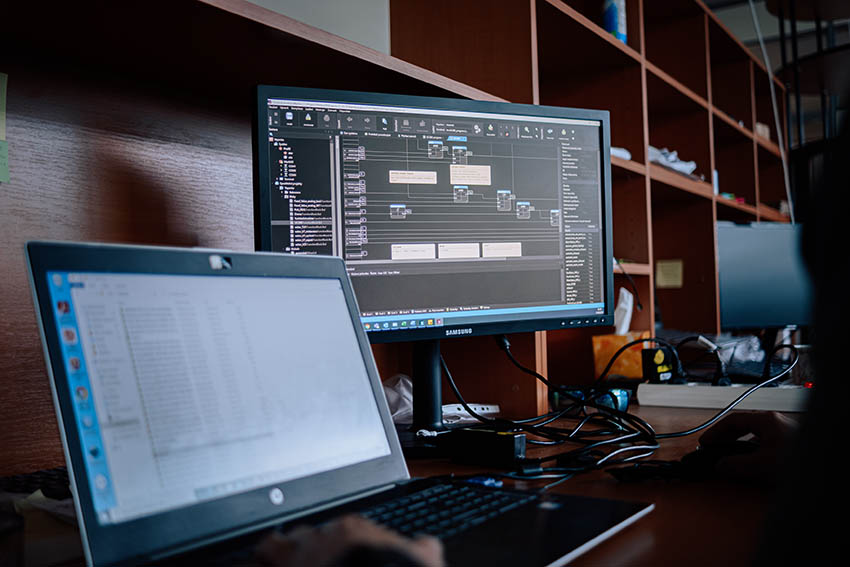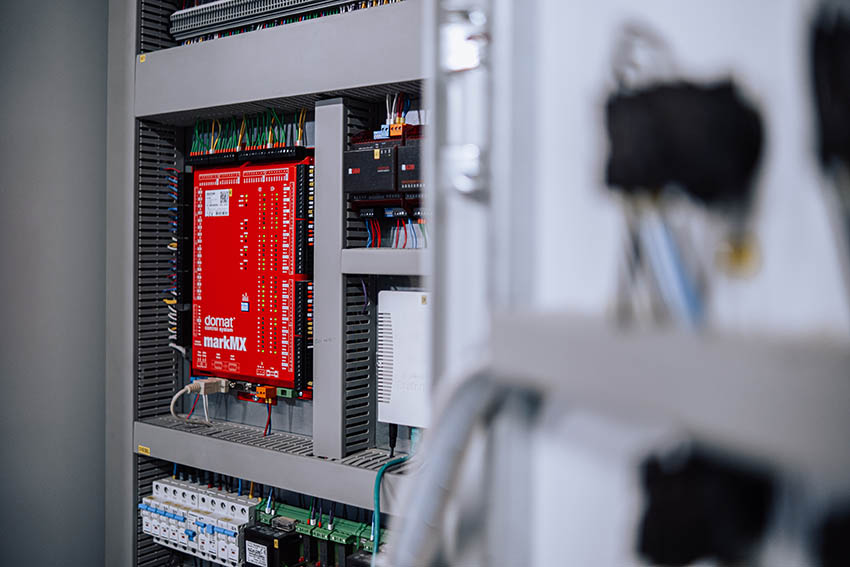Most buildings today have automatically integrated indoor management systems. For example, they adjust the heating or lighting according to the occupancy of the premises automatically, without human intervention. But only a fraction of users can use them effectively. The Sales Director, Tomáš Chadim, addressed the topic of decarbonization.
Most people associate decarbonization with energy or transport. What role do buildings play?
Tomáš Chadim: Essential, because buildings are major energy consumers worldwide. A significant part of the electricity or heat produced is consumed in them, whether we are talking about buildings for housing, services, offices, production or anything else. They have a significant impact on the production of CO2 emissions and at the same time a significant potential for its reduction.
How are we doing with the savings?
Tomáš Chadim: Many buildings have already undergone a process of reducing energy consumption through insulation and window replacement. Mainly as a result of various subsidies, a number of construction measures aimed at savings have already been taken. However, the problem is usually how users and operators of these facilities actually behave. No insulation or new windows will help when excess heat is ventilated, instead of the control system changing. Or energy-saving lighting, one of today’s trends – there’s nothing worth investing in energy-saving lighting when you’re shining with it when it’s not needed. Again, it’s about smart control and regulation.
How much can modern technology help?
Tomáš Chadim: More than it looks at first glance. As I have already indicated, the management and regulation system has a great influence on the savings and efficiency of the operation. In order to manage something effectively, you need data, information and the ability to make the right decisions based on them. This is exactly what today’s measurement and control systems are making possible. Modern systems work with an increasing amount of data and information and are thus able to effectively manage the environment in buildings. However, in order for such systems to work in this way, it is necessary to think about it from the very beginning of the preparation of construction or reconstruction of the building, and also during its operation. But it is still true, that if we want modern technology to serve us well, we must take good care of it.

Who do you supply such systems to? Developers, investors…?
Tomáš Chadim: These are our rarest clients. In reality, however, our most frequent customers for the supply of complete systems are construction companies. In the vast majority of cases, their motivation is different from the motivation of investors or future users and operators of buildings.
It is bad?
Tomáš Chadim: If we discuss the planned investment in the construction or reconstruction of a building directly with the investor, operator or future user of the building, the total cost of the building for its life cycle is almost always the main topic. From this point of view, economic logic clearly wins, where an efficient measurement and control system can save significant future operating costs with a negligible investment compared to the total construction and operating costs. The savings do not only concern energy consumption, but also the service life of the technological equipment of buildings as such.
The construction company usually looks at the construction only in terms of the costs of the construction phase, the subsequent operating costs do not apply to it. Therefore, it is not motivated to invest more at the cost of future savings. The main motivation of a construction company is to build as cheaply as possible. The investor, operator or user of the building will usually pay for this with higher operating expenses, but it is usually difficult to initiate a change.

What if an investor becomes aware of these aspects during construction, can something be done?
Tomáš Chadim: Of course, if there is interest, it is basically never too late. At the very least, it makes great sense to monitor the commissioning phase of the building and ensure adequate service support. Usually, buildings are handed over in some “default” setting, but this usually doesn’t suit anyone. You just have to realize it as an investor and not be satisfied with that default setting. If you do not underestimate the commissioning phase, the funds and efforts invested will certainly pay off in the form of unnecessarily unspent future costs and the satisfaction of the people who use the building.
Is it possible to estimate how many new constructions are being implemented today in the way you have just described?
Tomáš Chadim: Today, almost every building already has a system of measurement and regulation. But if I should say how many investors or developers are interested in how to use them efficiently and optimize them over the life of the building, then it is a percentage unit.
Don’t certifications help?
Tomáš Chadim: One part of the certification follows from the legislation. This will basically prevent a building with too high energy intensity from being built. So today you will not use inefficient boiler, inefficient lighting etc. The whole building is already in the preparation phase designed to be energetically rational. But the operational part is not considered at all. Technology that can be very efficient and economical when used properly works inefficiently if you run it badly.

And the commercial ones?
Tomáš Chadim: Commercial certifications have an incomparably higher potential to affect the phase of operation and use of the building. They emphasize that both construction and operation are environmentally sustainable and therefore energy efficient. It is not so long since building units have passed commercial certifications every year. Today I would like to say that there are dozens of them. Because demand for buildings that can be declared to be environmentally or energy-efficient is growing significantly.
So yes, they are useful. Unfortunately, these are very small numbers in the context of overall construction. So far, it is not the case that most objects have passed some commercial certification.
But the pressure on sustainability is growing.
Until recently, companies have addressed sustainability and published various reports, done marketing etc, but in my opinion very often only formally. This area has been really addressed in recent years, most notably the last year, maybe two. Social pressure in this area has grown very rapidly and many companies are trying very quickly to find a way to adapt to it and where else to start than in the building in which they are based?
How do you convince investors?
Tomáš Chadim: The vast majority of investors behave rationally, it must be economical for them. Today, there is a clear trend of rising energy prices, and this will be the main motivation for investing in efficient solutions and evaluating lifetime investments, not just at the beginning of construction. If energy is cheap and the technology that uses it expensive, no one has an incentive to invest in more energy-efficient equipment. But now times are changing very fast. All other reasons, in my experience, are secondary. It does not apply in one hundred percent, but in most cases it is. But maybe this is changing today, and emission savings will play a more important role than before.
It can be said that if we get in touch with the investor, developer at the time of project preparation of a new building or reconstruction and show him that today he will probably not build a technologically bad building, but can manage those quality technologies inefficiently, he will start looking for way to prevent it. The way is basically the only one – a properly designed measurement and control system and efficient operation of the building at the time of its use.
Is it possible to talk about returns in years, or is it individual?
Tomáš Chadim: It’s individual. We still talk about the measurement and control system, but then it depends on how someone handles it. If set well, the time is relatively short. I don’t want to say specific data over the years, because it really varies from case to case. But in general, we are one-third, but perhaps even one-fifth, of the payback period compared to thermal insulation or window replacement. Because you can achieve big savings in measurement and regulation or energy management at minimal cost.
What is the difficulty of operating these solutions?
Tomáš Chadim: Even in this area, times change significantly. Previously, the presence of qualified staff directly in the building was required. Today, everything can be controlled remotely, using a smartphone, tablet or computer. The software used to control the measurement and control systems is now accessible via the web environment as standard, and we already offer these solutions to our customers in the cloud. The cloud solution is an example of technological developments in the field of measurement and regulation. Very often, we use this solution for customers who need to manage a number of buildings, regardless of where the building is located and regardless of where the staff is located. I’m not talking about the fact that it is also a solution that has the potential to save investment on the part of the customer.
How is the Czech Republic doing compared to the world?
Tomáš Chadim: Technologically, I think that well, after all, the proof of this is that we are a Czech company and we successfully export our products and solutions to a number of countries around the world. Overall, however, we still have considerable potential in our approach to energy savings, especially compared to many Western countries. We have invested a lot in construction measures over the last 10 years or so, now I think there will be potential in technology and especially its management.

Is it possible that, in addition to economic pressure, someone will simply force companies to do so?
Tomáš Chadim: When energy audits arose, everyone took it as a duty. But from my point of view, there was a lack of real motivation. Today, the financial sector can be the driving force. Today, no one wants to finance environmentally unfriendly projects, on the contrary, everyone wants to finance the green ones. So it will be harder to get financing for unscrupulous buildings.
However, even customers who used to see something as an annoying obligation now see the same as a competitive advantage. Yes, I think there will come a time when it will be very difficult to obtain funding for environmentally unfriendly projects, and this can be a significant motivation.
You talked about energy prices, but they fly up and down.
Tomáš Chadim: It is evident that emission allowances play a major role in today’s high prices. You probably won’t just get cheaper. As the share of green energy grows, it will again be necessary to invest in distribution networks and their management. Which will require additional investment. So, I would say that the probability of a long-term decline in final, total energy prices is not very high.
Of course, there will be a huge number of those changes. It will be necessary to charge electric cars somewhere, any building will have photovoltaics on the roof. The price of energy will change during the day. It may continue to be cheaper at night when there is less consumption. But maybe on the contrary at noon thanks to the sunshine. In any case, new or green energy will have a huge impact on our habits and will force us to change our thinking. The pressure to change behavior will be enormous.


